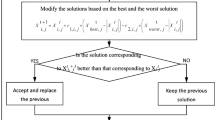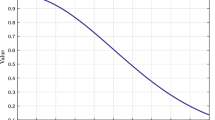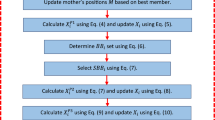Abstract
Jaya algorithm (JAYA) is a recently developed metaheuristic algorithm for global optimization problems. JAYA has a very simple structure and only needs the essential population size and terminal condition for solving optimization problems. However, JAYA is easy to get trapped in the local optimum for solving complex global optimization problems due to its single learning strategy. Motivated by this disadvantage of JAYA, this paper presents an improved JAYA, named comprehensive learning JAYA algorithm (CLJAYA), for solving engineering design optimization problems. The core idea of CLJAYA is the designed comprehensive learning mechanism by making full use of population information. The designed comprehensive learning mechanism consists of three different learning strategies to improve the global search ability of JAYA. To investigate the performance of CLJAYA, CLJAYA is first evaluated by the well-known CEC 2013 and CEC 2014 test suites, which include 50 multimodal test functions and eight unimodal test functions. Then CLJAYA is employed to solve five real-world engineering optimization problems. Experimental results demonstrate that CLJAYA can achieve better solutions for most test problems than JAYA and the other compared algorithms, which indicates the designed comprehensive learning mechanism is very effective. In addition, the source code of the proposed CLJAYA can be loaded from https://www.mathworks.com/matlabcentral/fileexchange/82134-the-source-code-for-cljaya.






Similar content being viewed by others
Abbreviations
- \({\mathbf{X}}\) :
-
Population
- \(N\) :
-
Population size
- \(D\) :
-
Dimension
- \({\mathbf{x}}_{i}\) :
-
The position of the ith individual
- \({\mathbf{v}}_{i}\) :
-
The candidate position of the ith individual
- \({\mathbf{x}}_{{{\text{BEST}},j}}\) :
-
The jth variable of the best individual
- \({\mathbf{x}}_{{{\text{WORST}},j}}\) :
-
The jth variable of the worst individual
- \({\mathbf{M}}\) :
-
The mean position of the population
- \(p_{{{\text{switch}}}}\) :
-
Switch probability
- \(p,q\) :
-
Integers between 1 and \(N\)
- \(\kappa_{1} ,\kappa_{2} ,\varphi_{5} ,\varphi_{6} ,\chi\) :
-
Random numbers between 0 and 1 with uniform distribution
- \(\varphi_{1} ,\varphi_{2} ,\varphi_{3} ,\varphi_{4}\) :
-
Random numbers with standard normal distribution
- \({\mathbf{L}}\) :
-
The lower boundary of the variables
- \({\mathbf{U}}\) :
-
The upper boundary of the variables
- \(F_{{{\text{current}}}}\) :
-
The current number of function evaluations
- \(F_{\max }\) :
-
The maximum number of function evaluations
- \(R_{N}\) :
-
The number of independent runs
- \({\mathbf{x}}^{*}\) :
-
The real optimal solution
- \(h_{t}\) :
-
The tth equality constraint
- \(g_{k}\) :
-
The kth inequality constraint
- \(m\) :
-
The number of equality constraints
- \(n\) :
-
The number of inequality constraints
- \(P({\mathbf{x}})\) :
-
The total penalty function
- \(H_{i} ({\mathbf{x}})\) :
-
The penalty function of the ith equality constraint
- \(G_{j} ({\mathbf{x}})\) :
-
The penalty function of the jth inequality constraint
- \(\eta_{i}\) :
-
The penalty factor of the penalty function of the ith equality constraint
- \(\xi_{j}\) :
-
The penalty factor of the penalty function of the jth inequality constraint
- MEAN:
-
Mean absolute error
- STD:
-
Standard variance
- NNA:
-
Neural network algorithm
- GWO:
-
Grey wolf optimizer
- WOA:
-
Whale optimization algorithm
- SCA:
-
Sine cosine algorithm
- JAYA:
-
Jaya algorithm
- TLBO:
-
Teaching–learning-based optimization
- CLJAYA:
-
Comprehensive learning Jaya algorithm
References
Amirjanov, A. (2006). The development of a changing range genetic algorithm. Computer Methods in Applied Mechanics and Engineering, 195(19), 2495–2508. https://doi.org/10.1016/j.cma.2005.05.014.
Arora, J. S. (1989). Introduction to optimum design. New York: McGraw-Hill.
Askarzadeh, A. (2016). A novel metaheuristic method for solving constrained engineering optimization problems: Crow search algorithm. Computers & Structures, 169, 1–12. https://doi.org/10.1016/j.compstruc.2016.03.001.
Baykasoğlu, A., & Ozsoydan, F. B. (2015). Adaptive firefly algorithm with chaos for mechanical design optimization problems. Applied Soft Computing, 36, 152–164. https://doi.org/10.1016/j.asoc.2015.06.056.
Brajević, I., & Ignjatović, J. (2019). An upgraded firefly algorithm with feasibility-based rules for constrained engineering optimization problems. Journal of Intelligent Manufacturing, 30(6), 2545–2574. https://doi.org/10.1007/s10845-018-1419-6.
Cheng, M.-Y., & Prayogo, D. (2014). Symbiotic organisms search: A new metaheuristic optimization algorithm. Computers & Structures, 139, 98–112. https://doi.org/10.1016/j.compstruc.2014.03.007.
Coello, C. A. C. (2000). Constraint-handling using an evolutionary multiobjective optimization technique. Civil Engineering Systems, 17(4), 319–346.
Coello, C. A. C., & Becerra, R. L. (2004). Efficient evolutionary optimization through the use of a cultural algorithm. Engineering Optimization, 36(2), 219–236.
Coello Coello, C. A. (2000). Use of a self-adaptive penalty approach for engineering optimization problems. Computers in Industry, 41(2), 113–127. https://doi.org/10.1016/S0166-3615(99)00046-9.
Coello Coello, C. A., & Mezura Montes, E. (2002). Constraint-handling in genetic algorithms through the use of dominance-based tournament selection. Advanced Engineering Informatics, 16(3), 193–203. https://doi.org/10.1016/S1474-0346(02)00011-3.
Du, T.-S., Ke, X.-T., Liao, J.-G., & Shen, Y.-J. (2018). DSLC-FOA : Improved fruit fly optimization algorithm for application to structural engineering design optimization problems. Applied Mathematical Modelling, 55, 314–339. https://doi.org/10.1016/j.apm.2017.08.013.
Eskandar, H., Sadollah, A., Bahreininejad, A., & Hamdi, M. (2012). Water cycle algorithm – A novel metaheuristic optimization method for solving constrained engineering optimization problems. Computers & Structures, 110–111, 151–166. https://doi.org/10.1016/j.compstruc.2012.07.010.
Faramarzi, A., Heidarinejad, M., Stephens, B., & Mirjalili, S. (2020). Equilibrium optimizer: A novel optimization algorithm. Knowledge-Based Systems, 191, 105190. https://doi.org/10.1016/j.knosys.2019.105190.
Gandomi, A. H., Yang, X.-S., & Alavi, A. H. (2011). Mixed variable structural optimization using Firefly Algorithm. Computers & Structures, 89(23), 2325–2336. https://doi.org/10.1016/j.compstruc.2011.08.002.
Gandomi, A. H., Yang, X.-S., & Alavi, A. H. (2013a). Cuckoo search algorithm: a metaheuristic approach to solve structural optimization problems. Engineering with Computers, 29(1), 17–35. https://doi.org/10.1007/s00366-011-0241-y.
Gandomi, A. H., Yang, X.-S., Alavi, A. H., & Talatahari, S. (2013b). Bat algorithm for constrained optimization tasks. Neural Computing and Applications, 22(6), 1239–1255. https://doi.org/10.1007/s00521-012-1028-9.
Gu, L., Yang, R., Tho, C.-H., Makowski, M., Faruque, O., & Li, Y. (2001). Optimization and robustness for crashworthiness of side impact. International journal of vehicle design, 26(4), 348–360.
Holland, J. H. (1975). Adaptation in natural and artificial systems: An introductory analysis with applications to biology, control, and artificial intelligence. Oxford, England: U Michigan Press.
Huang, J., Gao, L., & Li, X. (2015). An effective teaching-learning-based cuckoo search algorithm for parameter optimization problems in structure designing and machining processes. Applied Soft Computing, 36, 349–356. https://doi.org/10.1016/j.asoc.2015.07.031.
Li, J., Zhang, J., Jiang, C., & Zhou, M. (2015). Composite particle swarm optimizer with historical memory for function optimization. IEEE Transactions on Cybernetics, 45(10), 2350–2363. https://doi.org/10.1109/TCYB.2015.2424836.
Kamboj, V. K., Nandi, A., Bhadoria, A., & Sehgal, S. (2020). An intensify Harris Hawks optimizer for numerical and engineering optimization problems. Applied Soft Computing, 89, 106018. https://doi.org/10.1016/j.asoc.2019.106018.
Kennedy, J., & Eberhart, R. (1995). Particle swarm optimization. In Proceedings of ICNN’95-International Conference on Neural Networks (Vol. 4, pp. 1942–1948). IEEE.
Krohling, R. A., & dos Santos Coelho, L. (2006). Coevolutionary particle swarm optimization using gaussian distribution for solving constrained optimization problems. IEEE Transactions on Systems, Man, and Cybernetics, Part B (Cybernetics), 36(6), 1407–1416. https://doi.org/10.1109/TSMCB.2006.873185.
K.S., S. R., & Murugan, S. (2017). Memory based Hybrid Dragonfly Algorithm for numerical optimization problems. Expert Systems with Applications, 83, 63–78. https://doi.org/10.1016/j.eswa.2017.04.033.
Lampinen, J. (2002). A constraint handling approach for the differential evolution algorithm. In Proceedings of the 2002 Congress on Evolutionary Computation. CEC’02 (Cat. No.02TH8600) (Vol. 2, pp. 1468–1473 vol.2). https://doi.org/10.1109/CEC.2002.1004459
Lee, K. S., & Geem, Z. W. (2004). A new structural optimization method based on the harmony search algorithm. Computers & Structures, 82(9), 781–798. https://doi.org/10.1016/j.compstruc.2004.01.002.
Lee, K. S., & Geem, Z. W. (2005). A new meta-heuristic algorithm for continuous engineering optimization: harmony search theory and practice. Computer Methods in Applied Mechanics and Engineering, 194(36), 3902–3933. https://doi.org/10.1016/j.cma.2004.09.007.
Liu, H., Wang, Y., Tu, L., Ding, G., & Hu, Y. (2019). A modified particle swarm optimization for large-scale numerical optimizations and engineering design problems. Journal of Intelligent Manufacturing, 30(6), 2407–2433. https://doi.org/10.1007/s10845-018-1403-1.
Liu, H., Cai, Z., & Wang, Y. (2010). Hybridizing particle swarm optimization with differential evolution for constrained numerical and engineering optimization. Applied Soft Computing, 10(2), 629–640. https://doi.org/10.1016/j.asoc.2009.08.031.
Mirjalili, S. (2015). Moth-flame optimization algorithm: A novel nature-inspired heuristic paradigm. Knowledge-Based Systems, 89, 228–249. https://doi.org/10.1016/j.knosys.2015.07.006.
Mirjalili, S. (2016). SCA: A Sine Cosine Algorithm for solving optimization problems. Knowledge-Based Systems, 96, 120–133. https://doi.org/10.1016/j.knosys.2015.12.022.
Mirjalili, S., & Lewis, A. (2016). The whale optimization algorithm. Advances in Engineering Software, 95, 51–67. https://doi.org/10.1016/j.advengsoft.2016.01.008.
Mirjalili, S., Mirjalili, S. M., & Hatamlou, A. (2016). Multi-Verse Optimizer: a nature-inspired algorithm for global optimization. Neural Computing and Applications, 27(2), 495–513. https://doi.org/10.1007/s00521-015-1870-7.
Mirjalili, S., Mirjalili, S. M., & Lewis, A. (2014). Grey Wolf Optimizer. Advances in Engineering Software, 69, 46–61. https://doi.org/10.1016/j.advengsoft.2013.12.007.
Mohamed, A. W. (2018). A novel differential evolution algorithm for solving constrained engineering optimization problems. Journal of Intelligent Manufacturing, 29(3), 659–692. https://doi.org/10.1007/s10845-017-1294-6.
Rakhshani, H., & Rahati, A. (2017). Snap-drift cuckoo search: A novel cuckoo search optimization algorithm. Applied Soft Computing, 52, 771–794. https://doi.org/10.1016/j.asoc.2016.09.048.
Cheng, R., & Jin, Y. (2015). A competitive swarm optimizer for large scale optimization. IEEE Transactions on Cybernetics, 45(2), 191–204. https://doi.org/10.1109/TCYB.2014.2322602.
Rao, R. (2016). Jaya: A simple and new optimization algorithm for solving constrained and unconstrained optimization problems. International Journal of Industrial Engineering Computations, 7(1), 19–34.
Rao, R. V., Savsani, V. J., & Vakharia, D. P. (2011). Teaching–learning-based optimization: A novel method for constrained mechanical design optimization problems. Computer-Aided Design, 43(3), 303–315. https://doi.org/10.1016/j.cad.2010.12.015.
Rao, R. V., Savsani, V. J., & Vakharia, D. P. (2012). Teaching–learning-based optimization: An optimization method for continuous non-linear large scale problems. Information Sciences, 183(1), 1–15. https://doi.org/10.1016/j.ins.2011.08.006.
Rashedi, E., Nezamabadi-pour, H., & Saryazdi, S. (2009). GSA: A gravitational search algorithm. Special Section on High Order Fuzzy Sets, 179(13), 2232–2248. https://doi.org/10.1016/j.ins.2009.03.004.
Ray, T., & Liew, K. M. (2003). Society and civilization: An optimization algorithm based on the simulation of social behavior. IEEE Transactions on Evolutionary Computation, 7(4), 386–396. https://doi.org/10.1109/TEVC.2003.814902.
Sadollah, A., Bahreininejad, A., Eskandar, H., & Hamdi, M. (2013). Mine blast algorithm: A new population based algorithm for solving constrained engineering optimization problems. Applied Soft Computing, 13(5), 2592–2612. https://doi.org/10.1016/j.asoc.2012.11.026.
Sadollah, A., Sayyaadi, H., & Yadav, A. (2018). A dynamic metaheuristic optimization model inspired by biological nervous systems: Neural network algorithm. Applied Soft Computing, 71, 747–782. https://doi.org/10.1016/j.asoc.2018.07.039.
Samareh Moosavi, S. H., & Bardsiri, V. K. (2019). Poor and rich optimization algorithm: A new human-based and multi populations algorithm. Engineering Applications of Artificial Intelligence, 86, 165–181. https://doi.org/10.1016/j.engappai.2019.08.025.
Saremi, S., Mirjalili, S., & Lewis, A. (2017). Grasshopper optimisation algorithm: Theory and application. Advances in Engineering Software, 105, 30–47. https://doi.org/10.1016/j.advengsoft.2017.01.004.
Savsani, P., & Savsani, V. (2016). Passing vehicle search (PVS): A novel metaheuristic algorithm. Applied Mathematical Modelling, 40(5), 3951–3978. https://doi.org/10.1016/j.apm.2015.10.040.
Shadravan, S., Naji, H. R., & Bardsiri, V. K. (2019). The sailfish optimizer: A novel nature-inspired metaheuristic algorithm for solving constrained engineering optimization problems. Engineering Applications of Artificial Intelligence, 80, 20–34. https://doi.org/10.1016/j.engappai.2019.01.001.
Sharma, T. K., & Abraham, A. (2020). Artificial bee colony with enhanced food locations for solving mechanical engineering design problems. Journal of Ambient Intelligence and Humanized Computing, 11(1), 267–290. https://doi.org/10.1007/s12652-019-01265-7.
Storn, R., & Price, K. (1997). Differential evolution–a simple and efficient heuristic for global optimization over continuous spaces. Journal of global optimization, 11(4), 341–359.
Tanweer, M. R., Suresh, S., & Sundararajan, N. (2016). Dynamic mentoring and self-regulation based particle swarm optimization algorithm for solving complex real-world optimization problems. Information Sciences, 326, 1–24. https://doi.org/10.1016/j.ins.2015.07.035.
Wang, Y., Cai, Z., Zhou, Y., & Fan, Z. (2009). Constrained optimization based on hybrid evolutionary algorithm and adaptive constraint-handling technique. Structural and Multidisciplinary Optimization, 37(4), 395–413. https://doi.org/10.1007/s00158-008-0238-3.
Wolpert, D. H., & Macready, W. G. (1997). No free lunch theorems for optimization. IEEE Transactions on Evolutionary Computation, 1(1), 67–82. https://doi.org/10.1109/4235.585893.
Wu, L., Liu, Q., Tian, X., Zhang, J., & Xiao, W. (2018). A new improved fruit fly optimization algorithm IAFOA and its application to solve engineering optimization problems. Knowledge-Based Systems, 144, 153–173. https://doi.org/10.1016/j.knosys.2017.12.031.
Xiang, Z., Ji, D., Zhang, H., Wu, H., & Li, Y. (2019). A simple PID-based strategy for particle swarm optimization algorithm. Information Sciences, 502, 558–574. https://doi.org/10.1016/j.ins.2019.06.042.
Yang, X.-S., & Deb, S. (2014). Cuckoo search: recent advances and applications. Neural Computing and Applications, 24(1), 169–174. https://doi.org/10.1007/s00521-013-1367-1.
Yi, J., Li, X., Chu, C.-H., & Gao, L. (2019). Parallel chaotic local search enhanced harmony search algorithm for engineering design optimization. Journal of Intelligent Manufacturing, 30(1), 405–428. https://doi.org/10.1007/s10845-016-1255-5.
Yi, W., Gao, L., Pei, Z., Lu, J., & Chen, Y. (2020). ε Constrained differential evolution using halfspace partition for optimization problems. Journal of Intelligent Manufacturing. https://doi.org/10.1007/s10845-020-01565-2.
Zhang, J., Xiao, M., Gao, L., & Pan, Q. (2018). Queuing search algorithm: A novel metaheuristic algorithm for solving engineering optimization problems. Applied Mathematical Modelling, 63, 464–490. https://doi.org/10.1016/j.apm.2018.06.036.
Zhang, K., Huang, Q., & Zhang, Y. (2019). Enhancing comprehensive learning particle swarm optimization with local optima topology. Information Sciences, 471, 1–18. https://doi.org/10.1016/j.ins.2018.08.049.
Zhang, M., Luo, W., & Wang, X. (2008). Differential evolution with dynamic stochastic selection for constrained optimization. Nature Inspired Problem-Solving, 178(15), 3043–3074. https://doi.org/10.1016/j.ins.2008.02.014.
Zhang, Y., Jin, Z., & Chen, Y. (2020). Hybrid teaching–learning-based optimization and neural network algorithm for engineering design optimization problems. Knowledge-Based Systems, 187, 104836. https://doi.org/10.1016/j.knosys.2019.07.007.
Zhao, W., Zhang, Z., & Wang, L. (2020). Manta ray foraging optimization: An effective bio-inspired optimizer for engineering applications. Engineering Applications of Artificial Intelligence, 87, 103300. https://doi.org/10.1016/j.engappai.2019.103300.
Author information
Authors and Affiliations
Corresponding author
Ethics declarations
Competing interest
The authors declare that there is no conflict of interests regarding the publication of this paper.
Additional information
Publisher's Note
Springer Nature remains neutral with regard to jurisdictional claims in published maps and institutional affiliations.
Appendix A
Appendix A
A.1 welded beam design problem
A.2 Tension/compression spring design problem
A.3 Speed reducer design problem
A.4 Three-bar truss design problem
A.5 Car impact design problem
Rights and permissions
About this article
Cite this article
Zhang, Y., Jin, Z. Comprehensive learning Jaya algorithm for engineering design optimization problems. J Intell Manuf 33, 1229–1253 (2022). https://doi.org/10.1007/s10845-020-01723-6
Received:
Accepted:
Published:
Issue Date:
DOI: https://doi.org/10.1007/s10845-020-01723-6




